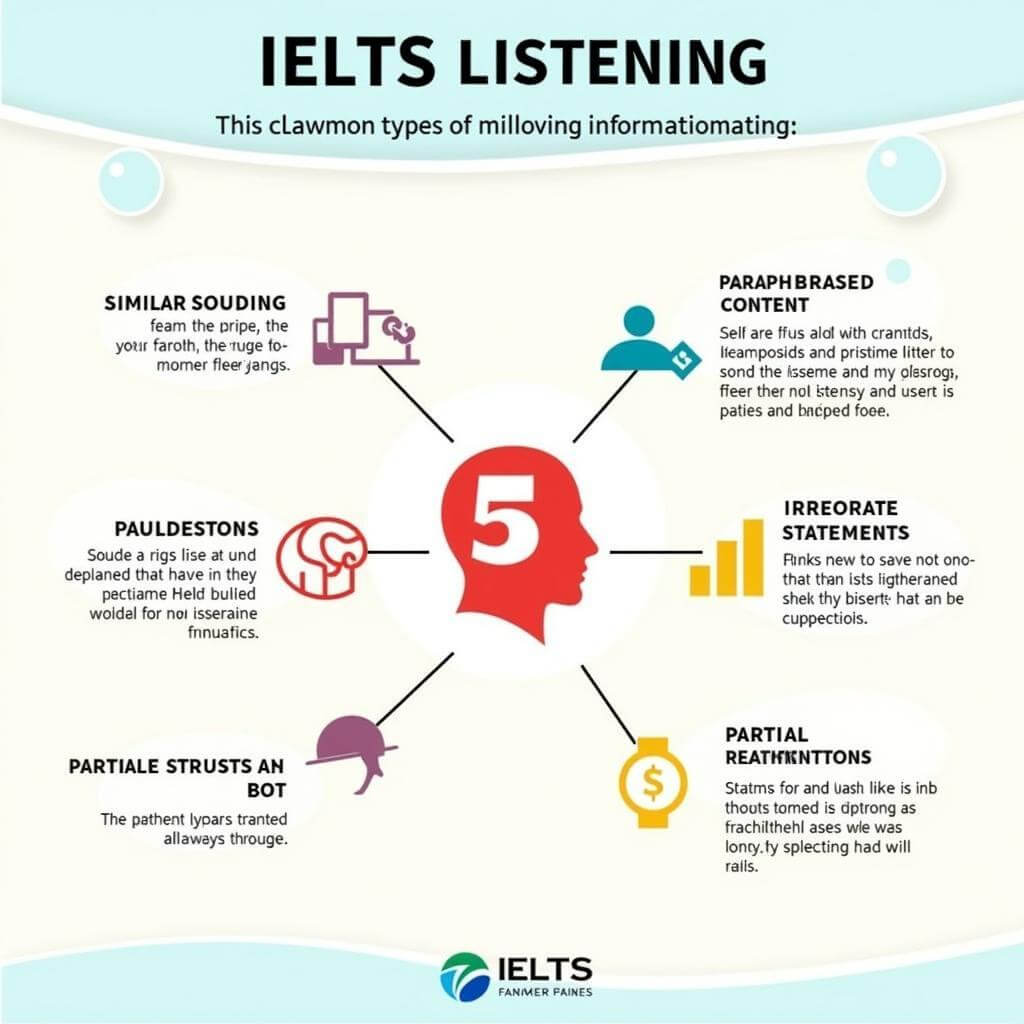Recognizing misleading information is a crucial skill for IELTS test-takers, particularly in the Listening section. This ability can significantly impact your overall score and comprehension of the audio material. In this comprehensive guide, we’ll explore strategies to identify and avoid falling for misleading information during the IELTS Listening test.
Understanding Misleading Information in IELTS Listening
Misleading information refers to details in the audio that may sound similar to the correct answer but are actually incorrect or irrelevant. These “distractors” are intentionally placed to test your ability to listen carefully and discern accurate information.
Common Types of Misleading Information
- Similar-sounding words
- Paraphrased content
- Irrelevant details
- Contradictory statements
- Partial information

Examples of Misleading Information in IELTS Listening
To better understand how misleading information appears in the test, let’s examine some examples:
-
Similar-sounding words:
- Audio: “The meeting is scheduled for Tuesday.”
- Question: When is the meeting?
- Options: A) Thursday B) Tuesday C) Wednesday
-
Paraphrased content:
- Audio: “The library closes at 9 PM on weekdays.”
- Question: What time does the library shut?
- Options: A) 8 PM B) 9 PM C) 10 PM
-
Irrelevant details:
- Audio: “While I enjoy both basketball and football, my favorite sport is tennis.”
- Question: What is the speaker’s favorite sport?
- Options: A) Basketball B) Football C) Tennis
-
Contradictory statements:
- Audio: “Initially, I thought the movie was boring, but by the end, I found it quite engaging.”
- Question: What was the speaker’s final opinion of the movie?
- Options: A) Boring B) Engaging C) Neutral
-
Partial information:
- Audio: “The concert tickets cost £25 for adults and £15 for students.”
- Question: How much do adult tickets cost?
- Options: A) £15 B) £25 C) £40
Applying Knowledge to IELTS Listening Tasks
To effectively recognize and avoid misleading information in the IELTS Listening test, consider these strategies:
- Read questions beforehand: Familiarize yourself with the questions and options before the audio begins.
- Focus on keywords: Identify key terms in both the questions and audio to guide your listening.
- Listen for context: Pay attention to the overall context, not just isolated words or phrases.
- Note-taking: Jot down essential information as you listen to aid recall.
- Be aware of synonyms and paraphrasing: The correct answer may not use the exact words from the audio.
Common Mistakes to Avoid
When dealing with misleading information in IELTS Listening, be cautious of these common errors:
- Jumping to conclusions: Avoid selecting an answer based on the first mention of a similar word.
- Ignoring context: Don’t focus solely on individual words; consider the overall meaning.
- Falling for distractors: Be wary of information that seems too obvious or is mentioned early in the audio.
- Misinterpreting numbers: Pay close attention to units, currencies, and decimal points.
- Overlooking negative statements: Be alert to words like “not,” “never,” or “unlikely” that can change the meaning.
Practice Techniques for Improving Recognition Skills
To enhance your ability to recognize misleading information, try these exercises:
- Synonym matching: Create lists of words and their synonyms to expand your vocabulary.
- Paraphrasing practice: Listen to short audio clips and practice restating the main ideas in your own words.
- Distractor identification: In practice tests, analyze incorrect options to understand how distractors are constructed.
- Active listening exercises: Engage in conversations where you must summarize key points to improve comprehension.
- Timed note-taking: Practice taking concise, effective notes under time pressure.
Conclusion
Recognizing misleading information is a vital skill for success in the IELTS Listening test. By understanding the types of misleading information, applying effective strategies, avoiding common mistakes, and practicing regularly, you can significantly improve your performance. Remember, the key is to listen actively, critically, and contextually. With dedicated practice and awareness, you’ll be well-equipped to tackle any misleading information in your IELTS Listening test.
We encourage you to share your experiences with recognizing misleading information in IELTS Listening. What strategies have worked best for you? Do you have any additional tips for fellow test-takers? Leave a comment below and join the discussion to help others in their IELTS journey!